ADATA Premier Pro SP920 256GB Solid State Drive Review
Chris Hadley / 10 years ago
Introduction
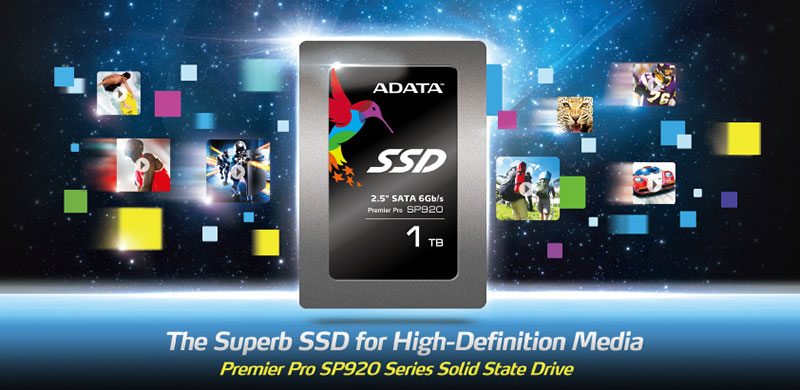
In the world of solid state drives, there are a vast number of advantages to be seen and had over the older mechanical counterparts and aside from raw capacity and the consequent price per GB of storage, the SSD is bar far the superior option to opt for when upgrading or building your new system. On the face of it, solid state drive are all about pure speed and whilst they are able to hit the limits of what the SATA III interface can handle, there is a whole lot more to the humble SSD to what lies on the surface and the crib sheets that are laid beside them.
The behind the scenes operations that hard drives rely on are pretty set in concrete and whilst there are some minor differences in performance to be seen, the way in which data is read and written to the drive stays the same with the iconic spinning platters and a read / write head which flickers back and forth hundreds of times a second. Solid state drives as we know by now are much more different and the lack of moving parts as indicated in their name means that everything is electronically altered within the silicon chips that are laid out on the PCB. How this data is read and accessed though does vary and overall we find three types of NAND available; synchronous, asynchronous and toggle. Typically we see most drives on the market offering up asynchronous or toggle mode NAND and this on the basic level comes down to the price. As we know, if you want better and more consistent performance, then you’ll be expecting to pay that bit more and this is exactly the case with synchronous NAND. The performance levels that are on offer on paper may look vastly greater, but in the real world the differences in speed are a lot closer than expected – the real advantage comes in sustained performance. I will go into this all a little later on to explain how it all works.
In the latter part of last week, ADATA gave us all a bit of a tease with an image on their Facebook page that teased us all with a portion of the drive on show with today’s date (2nd April 2014 for those not reading this on the launch date) down the left hand side. Buy why are ADATA keen to do this? Surely the launch of a new drive can’t be that special?
Well in some respects this is just another SSD; it doesn’t offer up a 2TB capacity as I’ve seen some speculate and ADATA haven’t found a way to rip through the limitations of the SATA III interface – nor is it a RAID0 drive within a single 2.5″ frame – damn I love it when people try to spread rumours! What the SP920 is, is in fact a drive that has been designed and built to meet the demands of our home entertainment driven lives and this where the aforementioned synchronous NAND comes into play.
Built around one of Marvell’s latest controllers, ADATA have chosen to use the more expensive NAND in favour of faster and more efficient file transfers from the drive – something which async and toggle mode drives struggle with as the volume becomes more congested with stored data. Multimedia files such as high-definition films and audio files or uncompressed data as we techs refer to them can put a lot of strain on the drive and in some cases we see the performance slowly drop down when being read – especially as the volume fills as mentioned above. This is what the SP920 is made to combat and thus why ADATA are proud to get the enthusiast community wanting more information.

Inside the SP920 packaging we get what is becoming a somewhat new industry standard bundle with a 2.5″ to 3.5″ drive bay adaptor, 7mm z-height to 9mm drive converter, screws for installation, quick start guide and a copy of Acronis’ drive migration software to make the upgrading process much quicker and less painful.
A Closer Look
With the new type of drive coming to ADATA’s product portfolio, we see a slight change in the design of the drive itself. A matt aluminium coloured case lightens up the drives appearance and on the top surface of the drive, a thin metal lid with a screw in each corner features a simple product label with the ADATA hummingbird at the top (as seen in the teaser image from last week) with the model and capacity printed below.
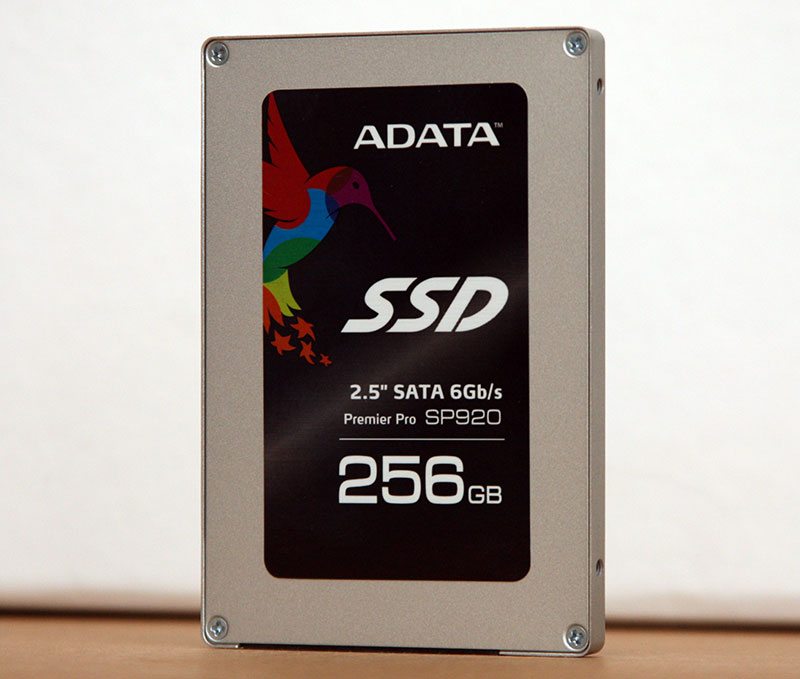
The plastic 2mm plate sits cleanly on the top of the drive allowing the SP920 to fit better in larger 2.5″ drive bays, leaving the label still on show in the middle.
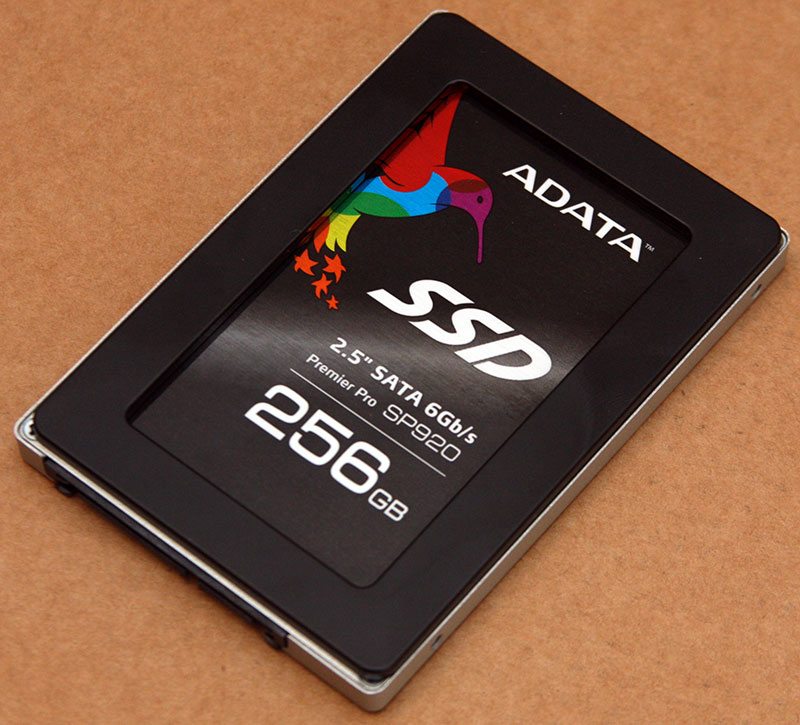
On the rear of the drive, there’s no surprises that we get he usual array of serial and model numbers, the key part that we have to note here is the serial key for the included copy of Acronis True Image Home. Placing the serial number where means you’ll never misplace the code – that’s unless you forget where you leave the drive!
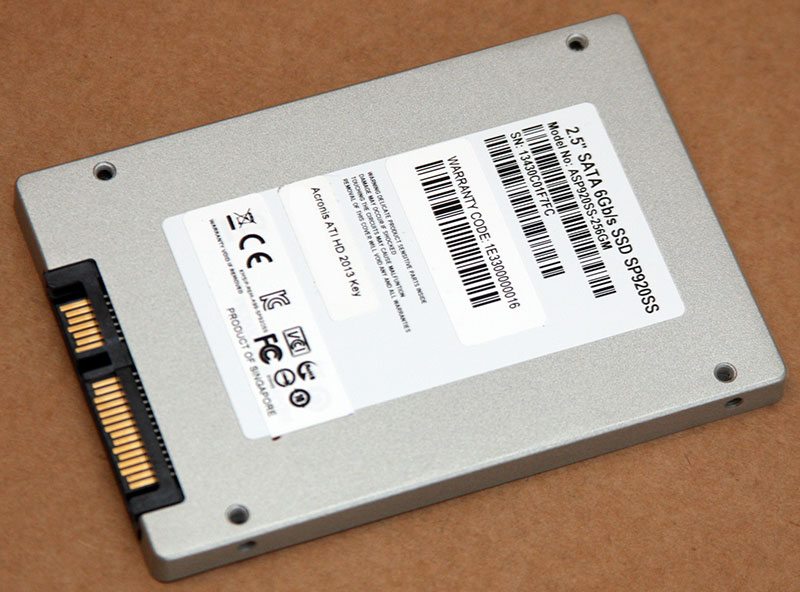
Opening up the drive (This will VOID your warranty!) we can see where the controller lies in relation to the drive casing – a thick thermal pad bridging the gap between the board and metal casing.
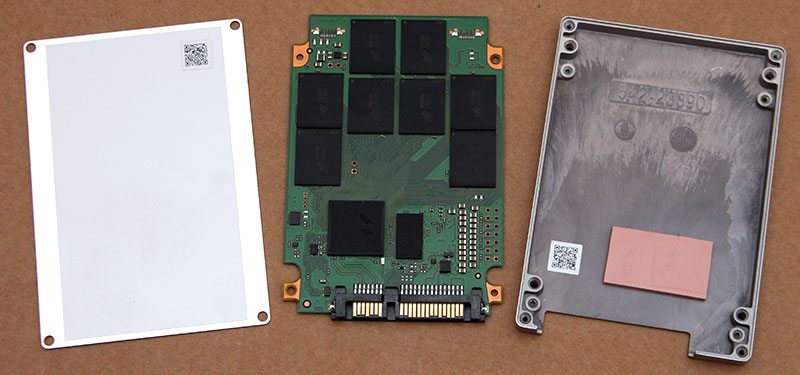
As far as component layout goes, the controller and memory sit close to the SATA header with eight NAND packages positioned towards the other end of the board.
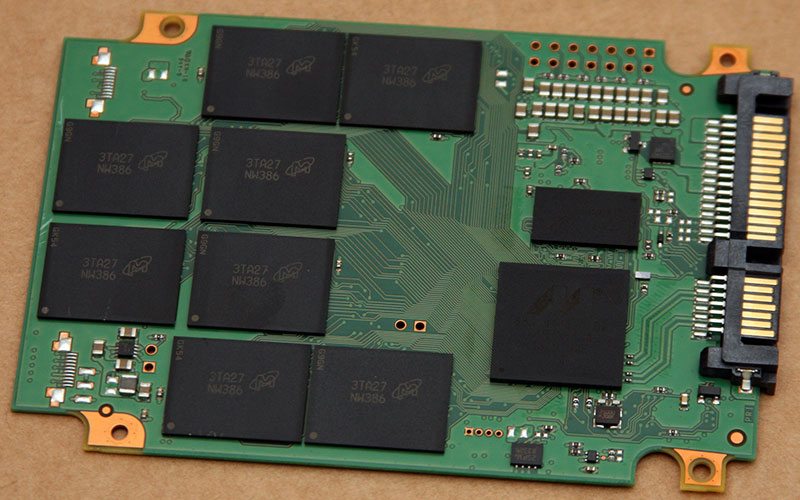
Making up the 256GB of storage on our review drive, ADATA have sought NAND from Micron and looking at the FBGA code that is printed on the face of the package we can ascertain that this is the same type of package as found on Crucial’s M550 that I looked at a couple of weeks back. Each of the (NW386) MT29F256G08CECABH6 packages here pack 64Gb per die, giving 256GB overall. Like the M550, the SP920 also offers up the full raw capacity to the end-user with no over provisioning needed.
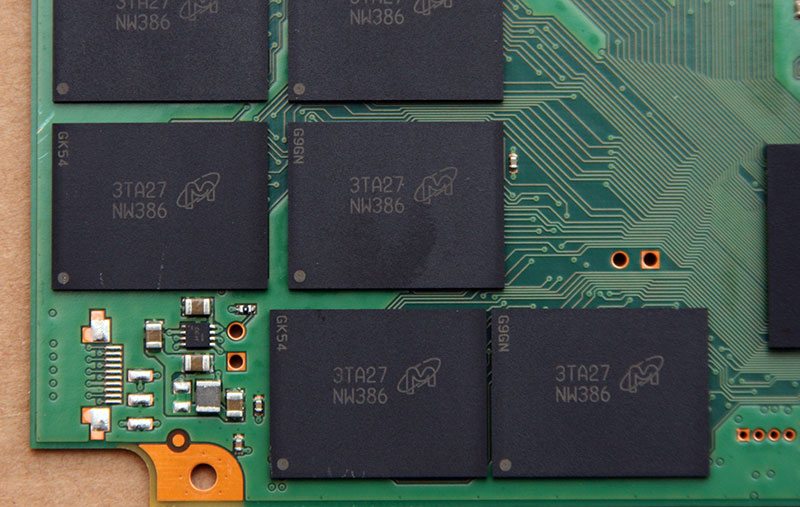
As mentioned above, the SP920 utilises a Marvell controller, specifically one of the latest 88SS9189-BLD2 single core 8 lane variants. Paired with this we have a 256MB DDR3 buffer again from Micron. (512GB models have 512MB DDR3 and 1TB models will sport 1GB DDR3)
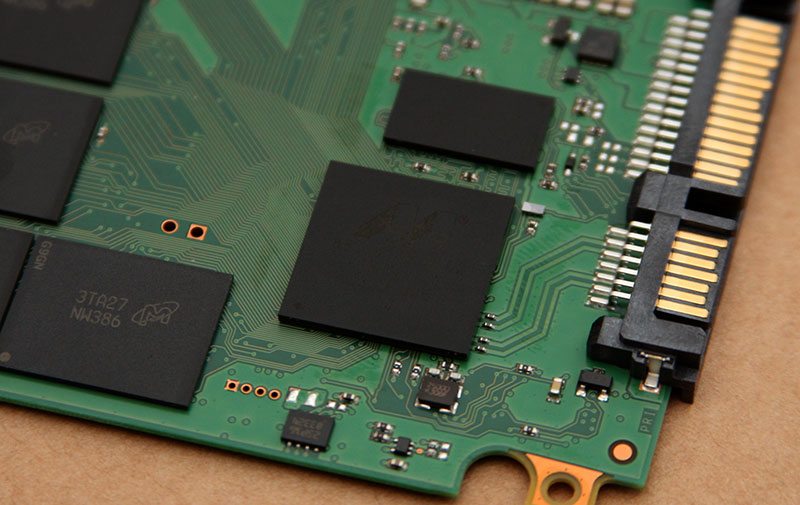
Over on the other side of the PCB there is not a lot going on, although the larger capacity 512GB and 1TB SSDs are likely to have this side of the board populated with more NAND packages.
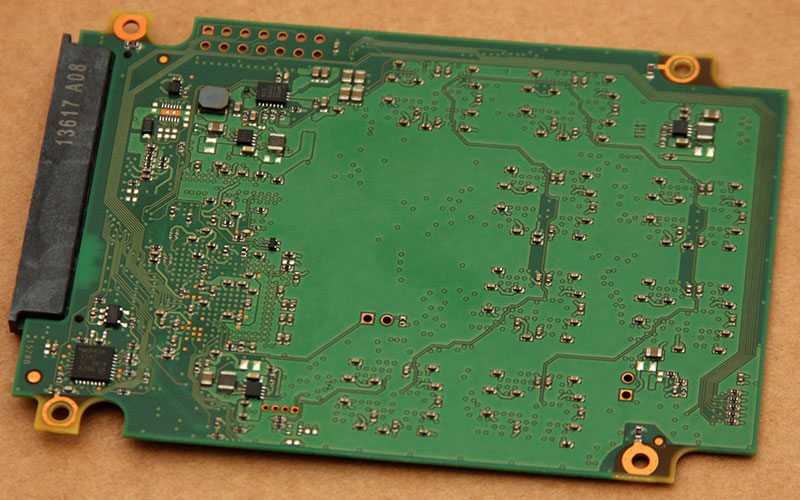
Test Procedure
Test system:
- Supermicro C7Z87-OCE
- Intel Xeon E3-1230Lv3
- Corsair Vengeance 16GB 1866MHz
- Corsair H100i
- Corsair HX1050W
- Kingston HyperX 240GB SSD
We would like to thank Supermicro, Intel, Corsair, Kingston and Lian Li for supplying us with our test system components.
Many different software applications are also used to gain the broadest spectrum of results, which allows for the fairest testing possible.
Software used:
- AIDA64
- AS SSD – Compression Benchmark
- ATTO
- CrystalDiskMark
- Anvil’s Storage Utilities RC6
- IOMeter
In a bid to make our testing as thorough and as accurate as possible, we are always looking for ways in which to tweak and tune our testing methodology and to give a clearer picture at how a drive performs throughout its life, I have formulated a new way of testing that gives eight times the amount of data to analyse within the review. Whilst this means that testing each drive will take considerably longer to test – nearly 36 hours in fact, the picture that we are able to build up of the overall performance of each drive is far clearer, providing a more accurate analysis at how a drive performs under different conditions.
The basis around the new method of testing is to do with how the performance of the drive improves or degrades as the amount of free space is reduced. To simulate this I will first of all test the drive when it is perfectly clean and fresh out of the box. Following on from this I will test the drive at key points as the volume is filled up with data, namely 25%, 50% and 75% full. As the type of data that is on the drive is directly relational to how the drive performs, I will be using a sample set of data that includes a mixture of small files such as text documents through medium-sized files such as photos and large video files. Intel’s NASPT suite that I use for NAS testing generates a 15GB block of data and as this contains a wide variety of file types and sizes, it is perfect for this application. To fill up the drive I will copy this block of data in to the root folder and copy it to fill the drive as required.
On top of this I will also take wear on the NAND in to consideration and this process obviously takes a long time to perform – so long under real world conditions that it is simply not practical. In order to accelerate this conditioning process I will use the SSD endurance test that lies within Anvils Storage Utilities and read / write 5TB of data to the drive through a process of filling the drive with thousands of small files of various sizes and compressibility (with randomised duration between each of the writes), then reading each of them back with a randomised time between each file. After this has completed, the data is then erased and the process starts again. This process of conditioning the drive can take anywhere upwards of 8-9 hours on a typical 256GB SATA III SSD, however the performance and capacity of the drive will influence the time it takes to condition the drive.
Following the conditioning process, the benchmarking process as described above is repeated again with the volume filled with sample data to each percentage between test runs. Furthermore between each benchmark test, the drive will be left alone to allow the TRIM command to take place if the drive feels it is necessary. From previous experience, TRIM can heavily impact the drives performance as it takes place, so allowing a period of time between tests will eliminate this factor and any subsequent false performance figures.
On each page that follows with the benchmark results, I have inserted the screenshots from the benchmark results when the drive is 75% full. In the drive comparison charts, the performance at 0% fill is used as these are the performance figures that I have recorded from drives in previous SSD reviews.
AIDA64 Storage
AIDA64 Extreme Edition is a streamlined Windows diagnostic and benchmarking software for home users. AIDA64 Extreme Edition provides a wide range of features to assist in overclocking, hardware error diagnosis, stress testing, and sensor monitoring. It has unique capabilities to assess the performance of the processor, system memory, and disk drives. AIDA64 is compatible with all current 32-bit and 64-bit Microsoft Windows operating systems, including Windows 7 and Windows Server 2008 R2.
Unconditioned
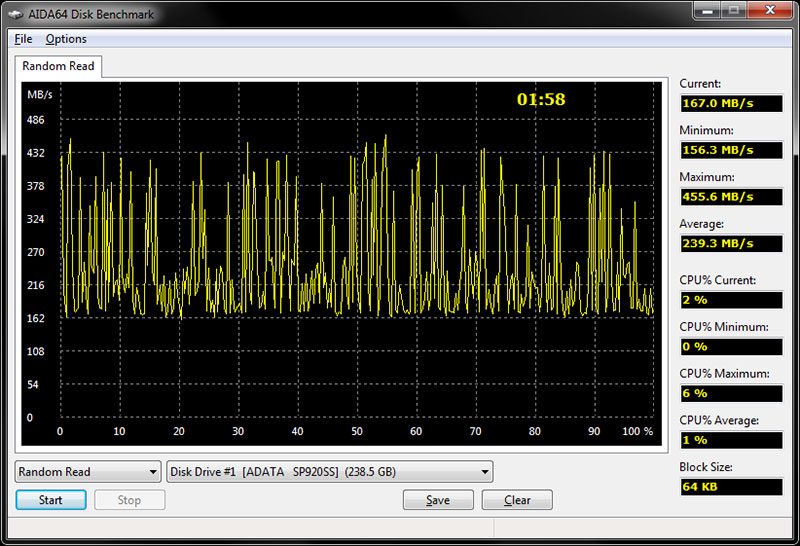
Conditioned
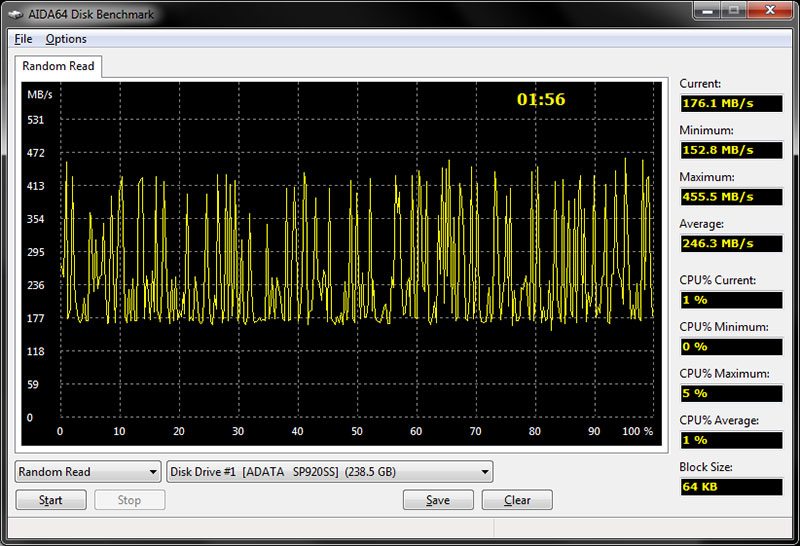
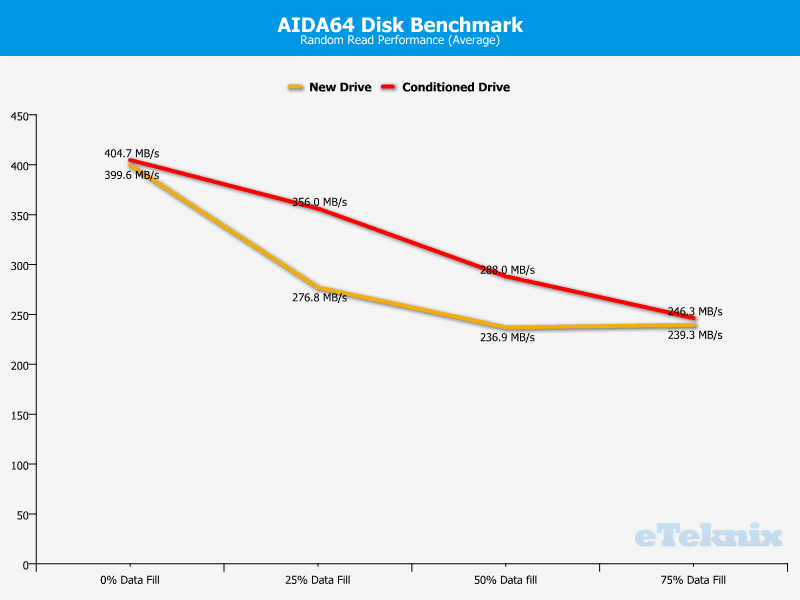
Typically within AIDA64 I see a general rise in the random read performance as the drive volume fills, however in the case of the SP920 what we see is the opposite. Whilst this may appear to show a poor performing drive, the results on the following pages will prove to you otherwise.
Drive Comparison
For the purpose of drive comparison I use the performance figures from both unconditioned and conditioned tests with 0% data fill.

Recording the random read speed of each drive that I review is only a recent addition to the testing process so there are only a small handful of drives to compare this to. The key factor to note from above is that the random read performance does improve, albeit slightly, over time.
AS SSD
The AS SSD software determines the performance of Solid State Drives (SSD). The tool contains five synthetic and three practice tests. The synthetic tests determine the sequential and random read and write performance of the SSD. These tests are performed without using the operating system caches. In Sequential tests the program measures the time it takes to read and write a 1GB file respectively. With most of the benchmark tests showing peak performance from an SSD, I’ve changed AS SSD a little to now give us a clearer picture as to how the drive will perform given variable levels of file compression.
Unconditioned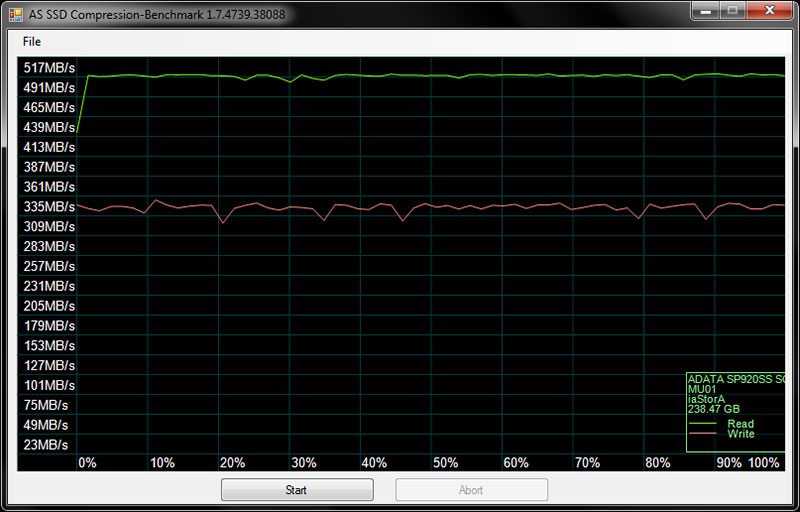
Conditioned
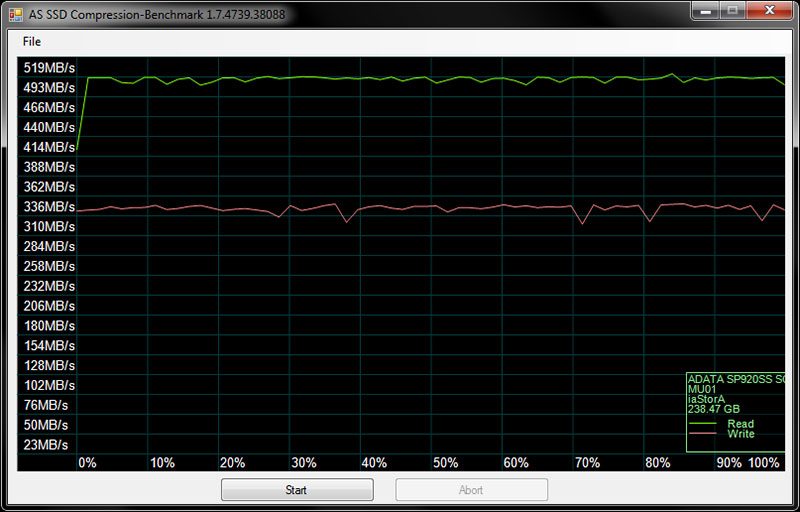
Handling data with varying compression is part of the SP920’s design brief and naturally we expect to see a near flat line as the level of compression is raised. The results show just that and we are by no means disappointed by the results.
ATTO
The ATTO Disk Benchmark performance measurement tool is compatible with Microsoft Windows. Measure your storage systems performance with various transfer sizes and test lengths for reads and writes. Several options are available to customize your performance measurement including queue depth, overlapped I/O and even a comparison mode with the option to run continuously. Use ATTO Disk Benchmark to test any manufacturers RAID controllers, storage controllers, host adapters, hard drives and SSD drives and notice that ATTO products will consistently provide the highest level of performance to your storage.
Unconditioned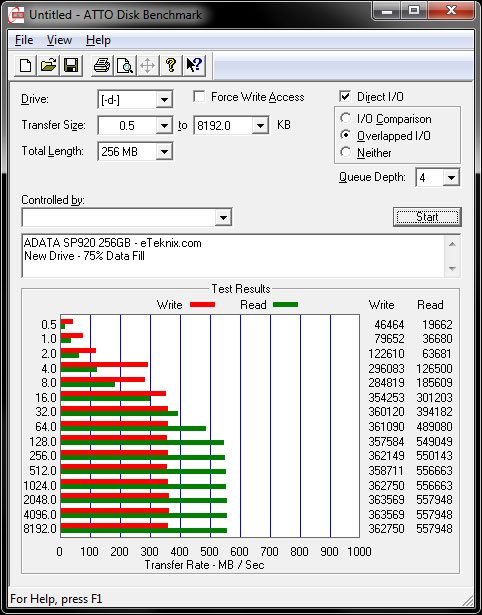
Conditioned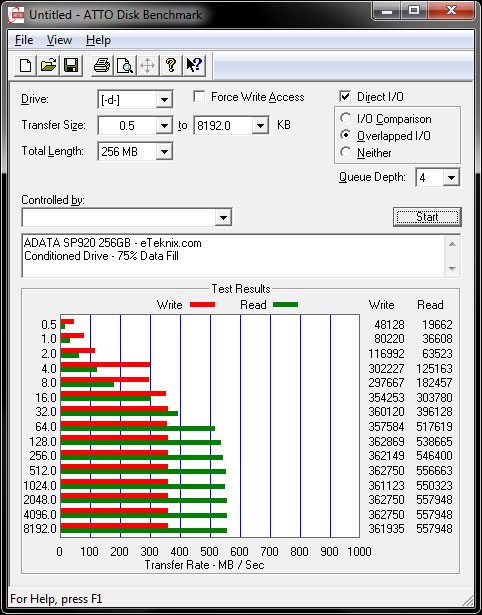
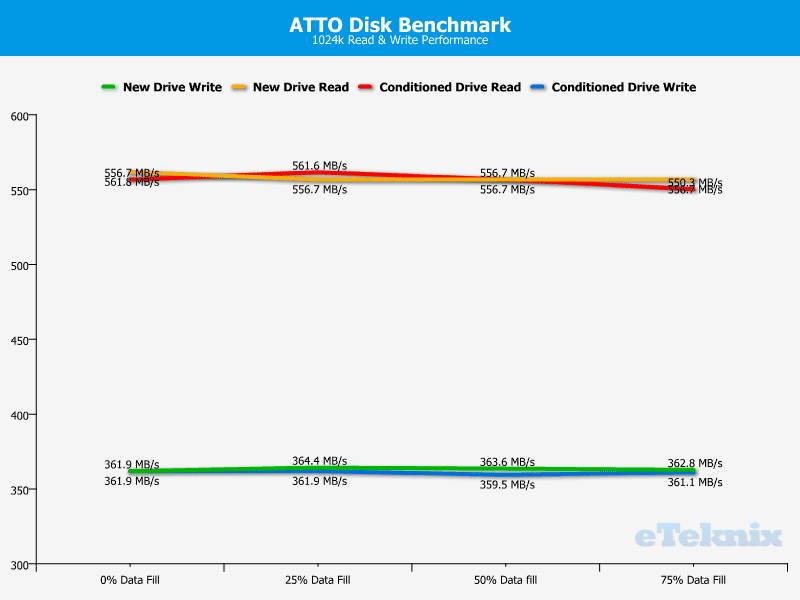
From start to finish we can see that there is virtually no deviation in the baseline performance that this drive has to offer. Granted the write speeds are a bit off the mark when compared to a number of other drives on the market, but it’s the read speed that really matters here.
Drive Comparison
For the purpose of drive comparison I use the performance figures from both unconditioned and conditioned tests with 0% data fill.
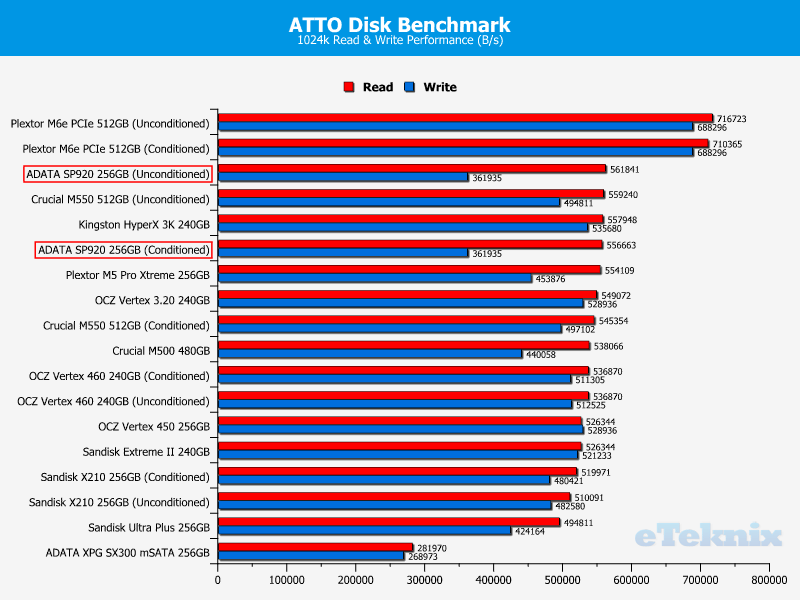
Following the introduction to the SP920 I was expecting this drive to be one of the top contenders for out-and-out SATA performance and ADATA’s drive was eager to please. With a read speed that tops 560MB/s this is by a short stretch the fastest drive that I have tested on a SATA III interface to date – hopefully the real world speeds can follow suit.
CrystalDiskMark
CrystalDiskMark is a small HDD benchmark utility for your hard drive that enables you to rapidly measure sequential and random read/write speeds.
Here are some key features of “CrystalDiskMark”:
- Sequential reads/writes
- Random 4KB/512KB reads/writes
- Text copy
- Change dialog design
- internationalization (i18n)
Unconditioned
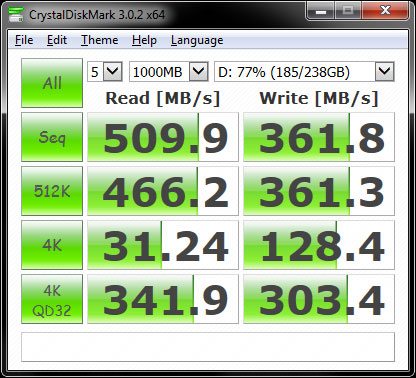
Conditioned
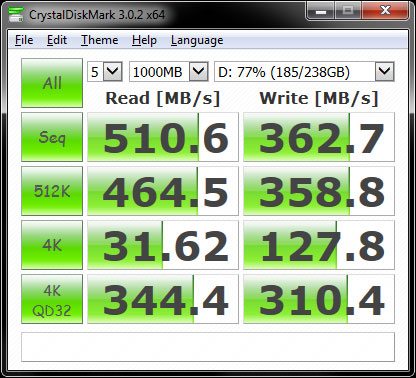
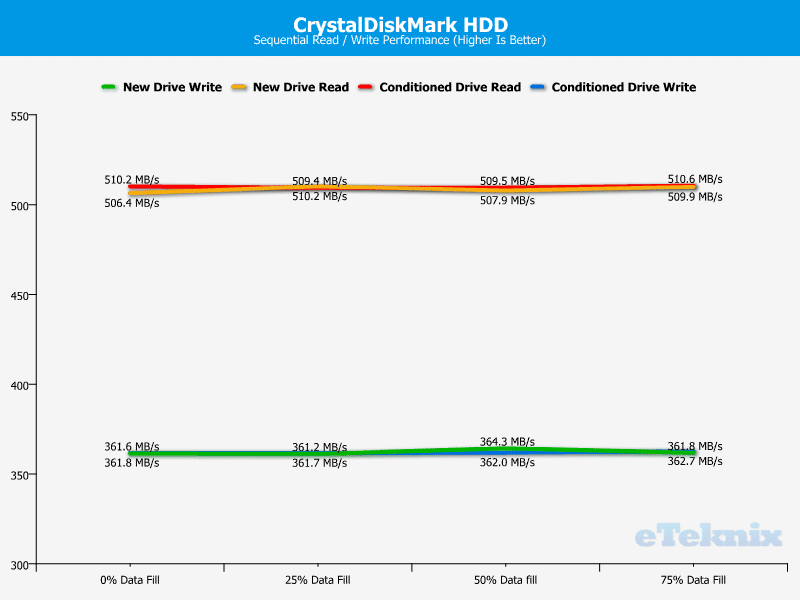
Like ATTO, CDM gives us a set of lines that stay close to flat across the spread of data collected. Consistent performance figures are key to a strong drive.
Drive Comparison
For the purpose of drive comparison I use the performance figures from both unconditioned and conditioned tests with 0% data fill.
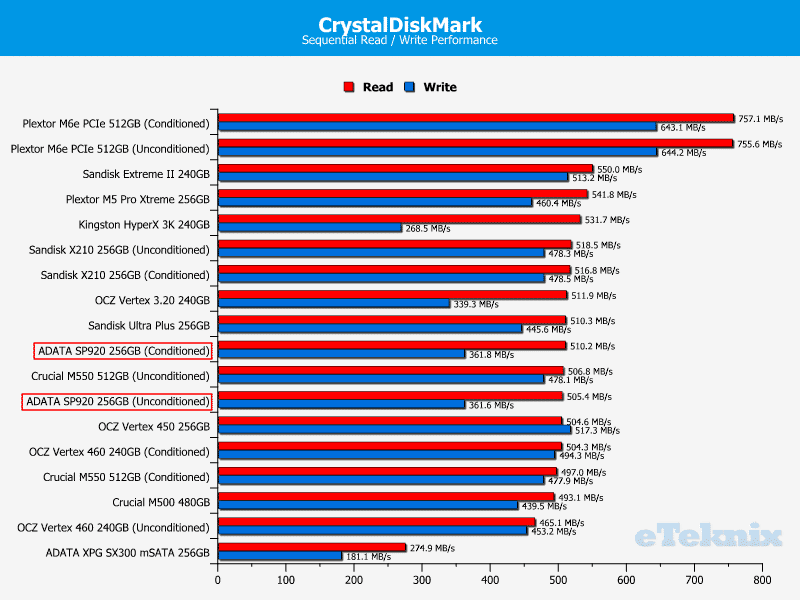
Unlike the results within ATTO, the real world speeds are a little down on those expected however as mentioned on the individual drive metrics, the 920 gives us it’s best fresh out of the box and just as we would expect from an array of synchronous NAND packages.
Anvil’s Storage Utilities
Anvil’s Storage Utilities is a new benchmarking utility that we have started using here at eTeknix, it’s completely free to download and has the ability to test mainly hard drives and solid state drives, but also any other form of storage medium that you can throw at it. As well as testing the drive in a variety of benchmarking tests, it also has a drive endurance test that consistently reads and writes data to the selected medium to give days, months and potentially even years of use in a shorter period of time to see how the drive copes in the longer term.
Unconditioned
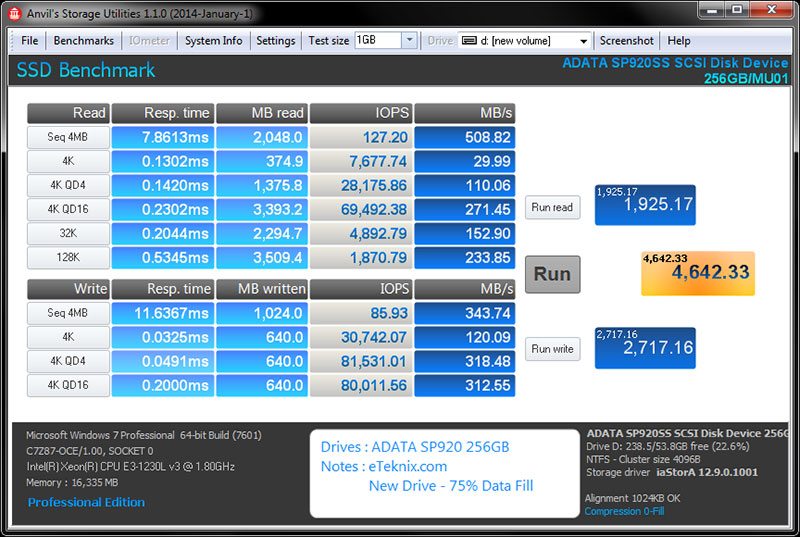
Conditioned
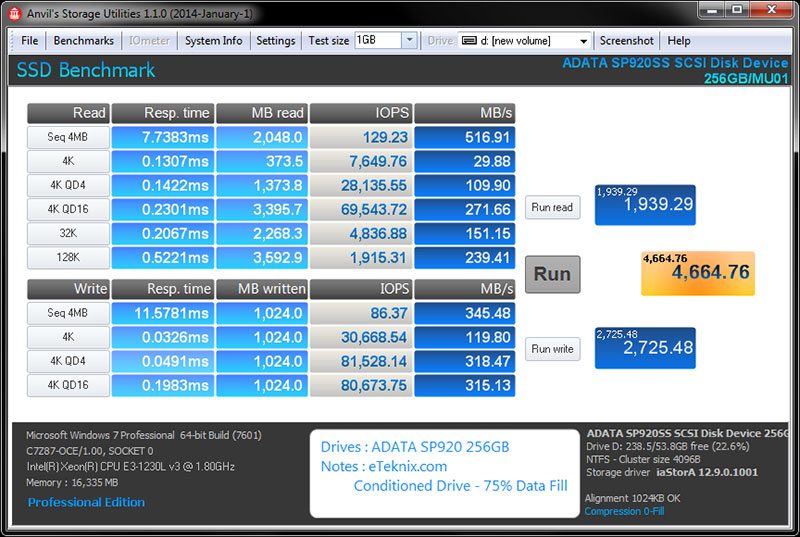
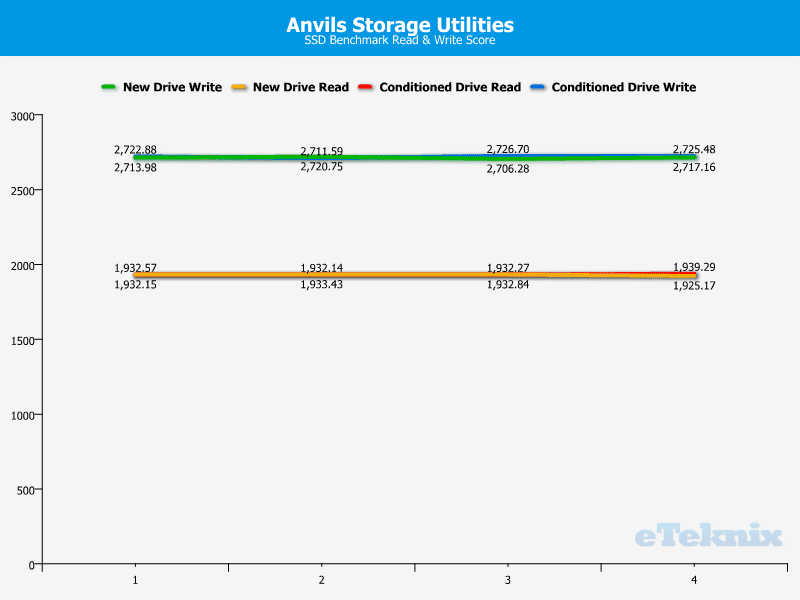
As Anvil’s gives us a wider impression as to how the drive is performing we can see some fairly strong results on the 4k and 32k sectors with speeds that are heads above the competition.
Drive Comparison
For the purpose of drive comparison I use the performance figures from both unconditioned and conditioned tests with 0% data fill.
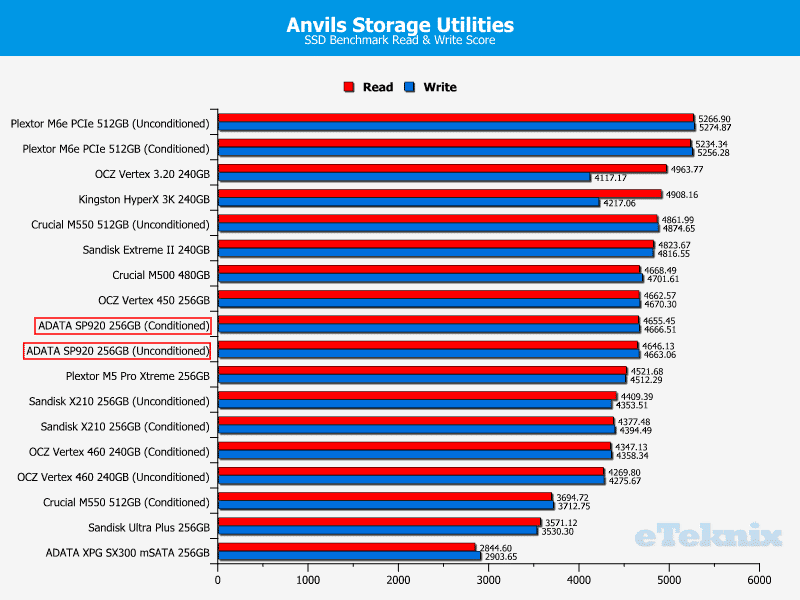
Surprisingly the 920 appears in the middle of the Anvil’s results table although I would put part of this down to the short test time at each file size.
IOMeter
IOMeter is an I/O subsystem measurement and characterization tool for single and clustered systems. It is used as a benchmark and troubleshooting tool and is easily configured to replicate the behaviour of many popular applications. One commonly quoted measurement provided by the tool is IOPS.
IOMeter allows the configuration of disk parameters such as the ‘Maximum Disk Size’, ‘Starting Disk Sector’ and ‘# of Outstanding I/Os’. This allows a user to configure a test file upon which the ‘Access Specifications’ configure the I/O types to the file. Configurable items within the Access Specifications are:
- Transfer Request Size
- Percent Random/Sequential distribution.
- Percent Read/Write Distribution
- Aligned I/O’s.
- Reply Size
- TCP/IP status
- Burstiness.
Unconditioned Read / Write
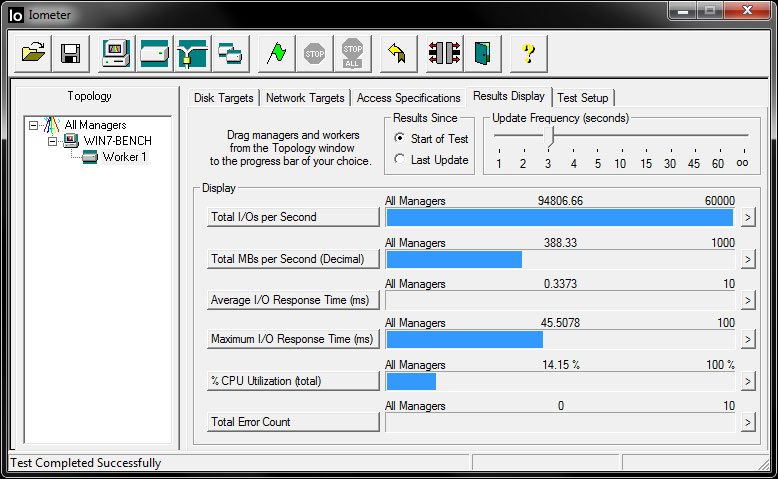
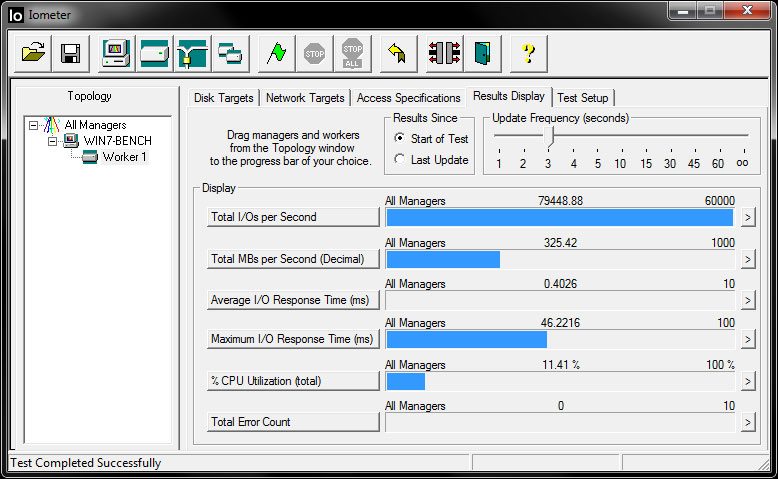
Conditioned Read / Write
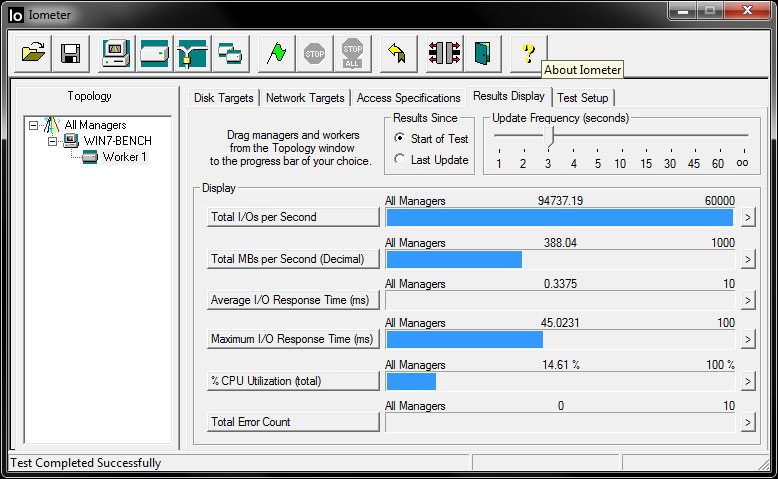
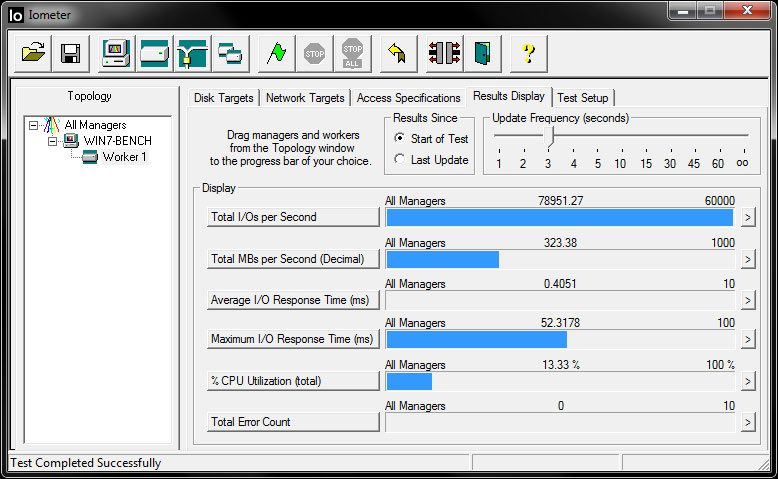
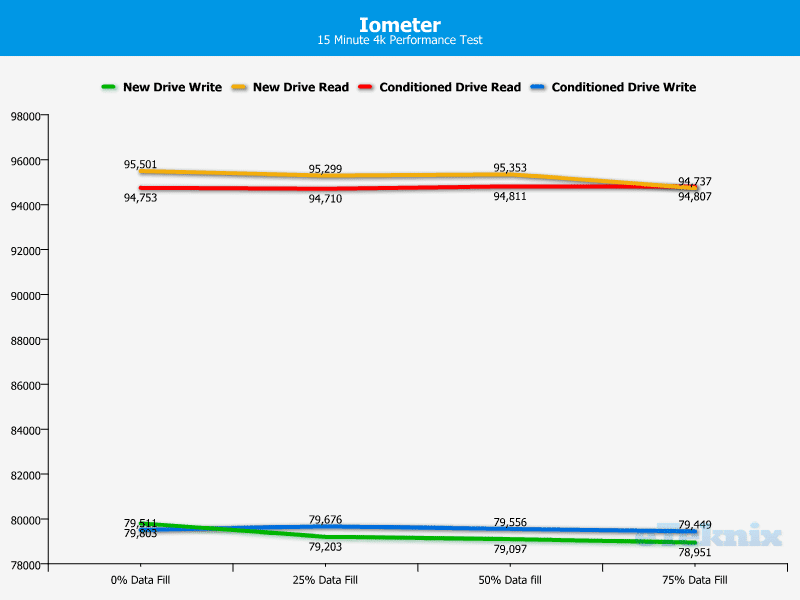
The other part of this drive that ADATA are keen to shout about is the IOPs performance. When reading multimedia files, IOPs is just as and if not more than important. Like the read and write speeds seen on the previous pages, the IOPs results are superb to see with high levels of performance see right out of the box and they stay right at that level throughout the testing period.
Drive Comparison
For the purpose of drive comparison I use the performance figures from both unconditioned and conditioned tests with 0% data fill.
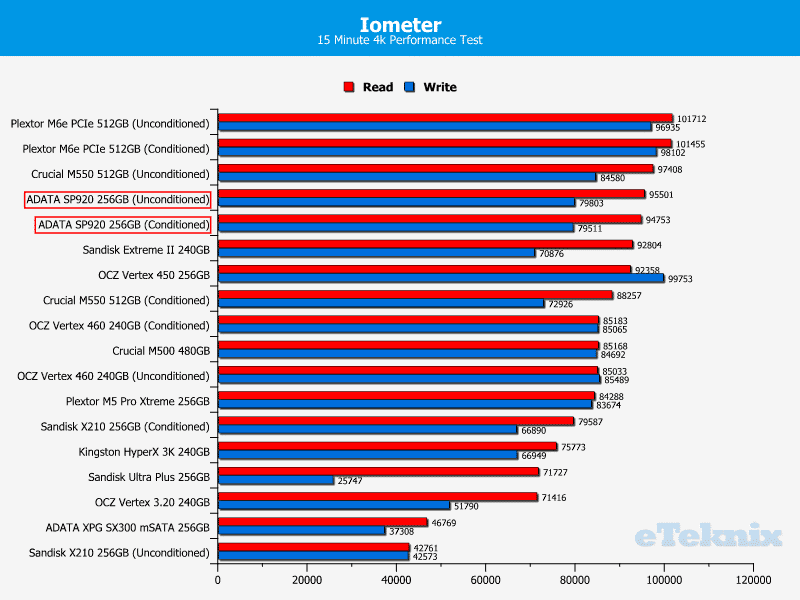
With such a high level of read IOPs performance, the SP920 is close to being the leader of the SATA based group of drives with the M550 just nudging in front. Whats more important though is how the performance fairs over time and this is where the SP920 comes in to its own, with just shy of 95k read and 80k write measured.
Final Thoughts
Pricing
One of the most remarkable things about this drive to me is not its consistently high levels of performance, although this is a major feature of the SP920, but the price is even more staggering. Synchronous NAND is typically more expensive than asynchronous or toggle mode NAND to buy and this is typically why we see these latter two NAND types being used. Somehow though ADATA have managed to not only hit the performance nail on the head, but also the price point as well. In the US, this 256GB drive has an MSRP of $159.99 which works out at only 62 cents per GB – in the UK things are relatively similar with the same 256GB drive sporting a sub £120 price tag and only 47 pence per GB. Yes you have heard it – a 256GB SSD that is below 50p a GB – bang for buck – it’s a bit of a no brainer this time round really isn’t it?
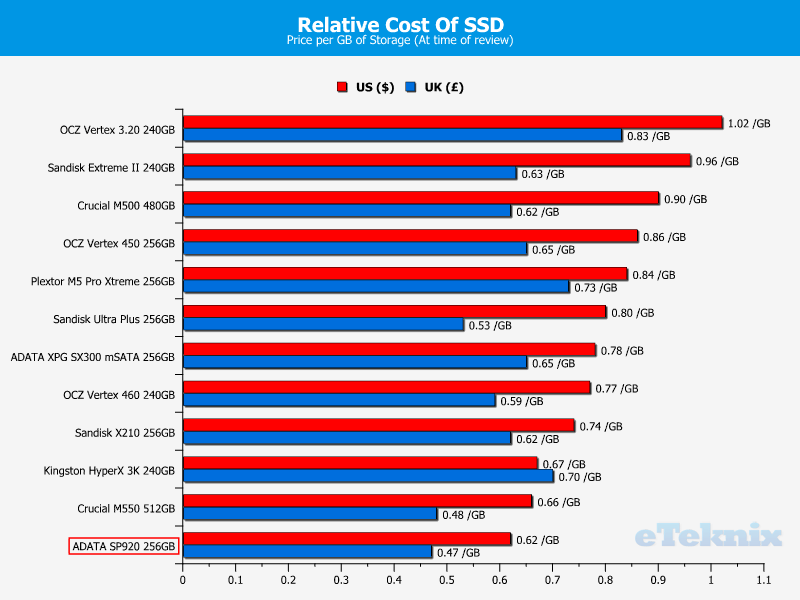
Overview
At the start of the review is asked what is the significance of this SSD release and even though this is not the first time we have seen synchronous NAND used in the design of a SSD, what ADATA have done with the drive as a whole is far more important and thus worth shouting about.
Bar the random read performance as recorded within AIDA64, each of the following results charts show performance lines that are near flat with no rise or fall in drive performance as the volume fills and the NAND incurs more read / write cycles. Some of you may be thinking that a flat line means that this drive doesn’t get better over time and thus is not as good as those that do, but in reality this mind-set should be the other way round. From the moment I put this drive on the bench and put it through its paces, it was delivering all that it had to give right from the start. What’s more the means that not only are you going to be getting superior levels of performance out of the box, you will ALWAYS get this top-level of performance – no matter how much data is on the drive.
When we look at the wider picture, ADATA built this drive for the purpose of multimedia data transfer and especially uncompressed files such as audio and video. By strictly selecting the best NAND available and optimising the controller to work with synchronous NAND in this manner, a drive has been produced that is close to taking each performance metric right to the outer limits of what SATA III is capable of – I’m taking about more than sequential read and write performance here.
With the SSD market constantly growing and the gap between each vendor closing up on the upper end of the performance charts, no longer is it a fast sequential speed that will make you the king of SSDs. All round performance and a lower cost of ownership is where the market is going and the SP920 is without a doubt in this new league of drives.
Pros:
- Consistent drive performance throughout the drives lifespan
- High levels of performance in most of the benchmark areas
- Ultra low price per GB of storage
- Synchronous NAND optimised with a Marvell controller
- Designed for multimedia applications
Cons:
- Write performance levels slightly lower than other drives at this level
“Switching over to synchronous NAND may seem to be a risky decision in a highly competitive SSD market – especially when performance and price is taken into account. ADATA have taken the challenge face on to deliver a drive that gives top levels of multimedia performance, with a price that is simply staggering. Not only this but they have got performance figures that are consistent across the drives conditioning period – once they get the write speeds and IOPs up to the same level they will have hit the jackpot with the perfect drive.”
Thanks to ADATA for providing this review sample.




















